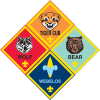Belt Loop
Complete these three requirements 
- Explain the scientific method to your adult partner
- Use the scientific method in a simple science project. Explain the results to an adult.
- Visit a museum, a laboratory, an observatory, a zoo, an aquarium, or other facility that employs scientists. Talk to a scientist about his or her work.
Academics Pin
Earn the Science belt loop and complete five of the following requirements.
- Make a simple electric motor that works.
- Find a stream or other area that shows signs of erosion. Try to discover the cause of the erosion.
- Plant seeds. Grow a flower, garden vegetable, or other plant.
- Use these simple machines to accomplish tasks: lever, pulley, wheel-and-axle, wedge, inclined plane, and screw.
- Learn about solids, liquids, and gases using just water. Freeze water until it turns into ice. Then, with an adult, heat the ice until it turns back into a liquid and eventually boils and becomes a gas.
- Build models of two atoms and two molecules, using plastic foam balls or other objects.
- Make a collection of igneous, metamorphic, and sedimentary rocks and label them.
- Learn about a creature that lives in the ocean. Share what you have learned with your den or family.
- Label a drawing or diagram of the bones of the human skeleton.
- Make a model or poster of the solar system. Label the planets and the sun.
- Do a scientific experiment in front of an audience. Explain your results.
- Read a book about a science subject that interests you. Tell your den or an adult family member about what you learned.
- money in carrying out its work.
Resources
Visit libraries, science museums, and college and university science departments. If you have access to the World Wide Web on the Internet, use search engines to look for the information you need. (Be sure you have your parent’s or adult partner’s permission first.)
Additional Information
The Scientific Method
Scientists are always trying to create an accurate picture or description of the world around us. They want to do this without their own opinions or biases getting in the way of how they see things, so they use an objective method of discovery as they develop their theories about the world.
- Purpose: You start off wanting to find out the answer to a question — usually one that you arrive at by observing the world around you. For instance, if you see plants wilting when they don’t get enough water, you might ask, “How much water do plants need to grow?”
- Hypothesis: What do you think will happen? For instance, “I hypothesize that if I water the plants once a week, they will grow.”
- Materials and Procedures: What do you need and what will you do to find out the answer to your question, or “test” your hypothesis? This part of the scientific method is important so that other people can repeat your experiments and see whether they get the same results.
- Data Collection: Write down everything you observe during your experiments and organize your data so that it is clear (perhaps using tables or graphs).
- Conclusions: From your data, you can draw conclusions about your hypothesis—whether it is true or false. For instance, if you found out that plants were healthy and grew when you watered them once a week, you could conclude that your hypothesis was true. But if they turned brown because they got too much water, you could conclude that your hypothesis was not true, and that watering once a week is too much.
Judging Science Projects
When judging science projects, consider the following areas:
- Scientific Method and Thought: Does the project follow the scientific method?
- Originality: Is the project mainly the work of the child?
- Thoroughness: Are all parts of the project done well?
- Technical Skill: Does the project show effort and craftsmanship?
- Clarity: Is the project easily understood?






